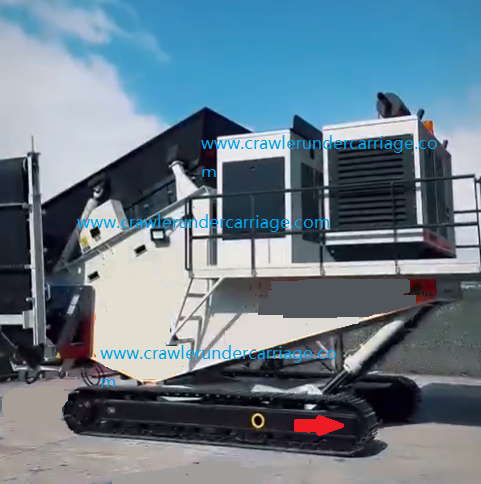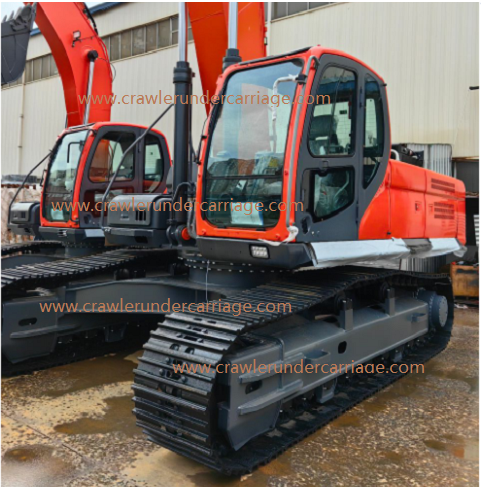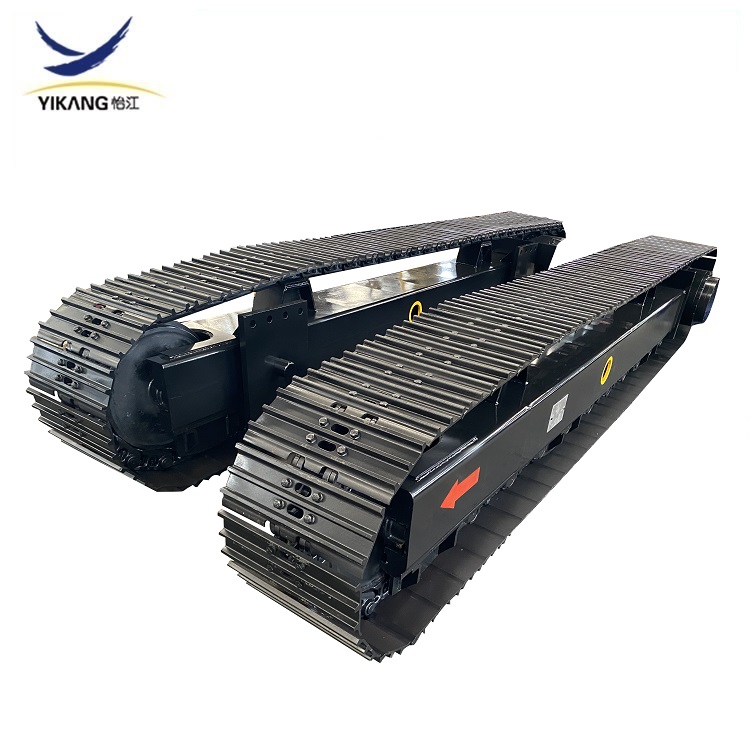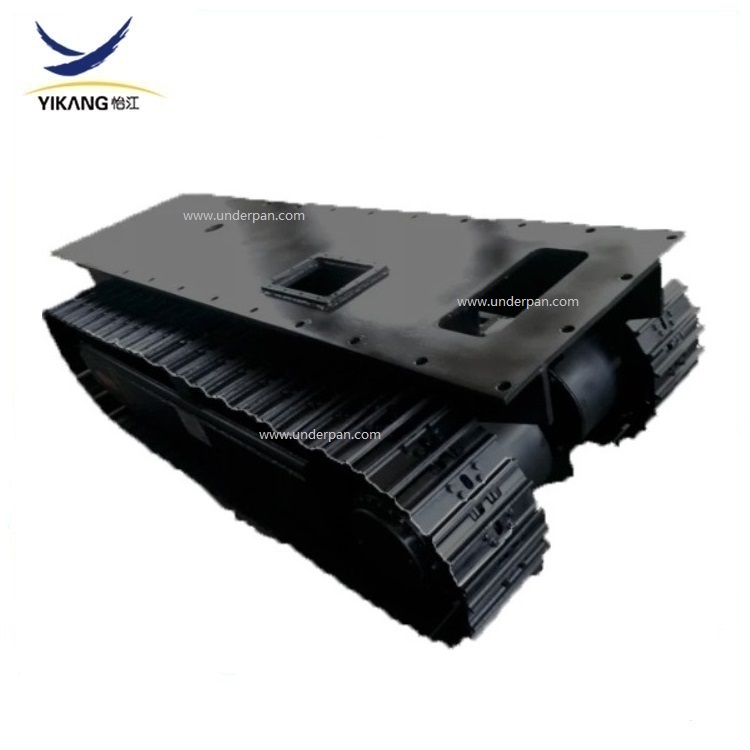The heavy machinery undercarriage chassis is a core component that supports the overall structure of the equipment, transmits power, bears loads, and adapts to complex working conditions. Its design requirements must comprehensively consider safety, stability, durability, and environmental adaptability. The following are the key requirements for the design of heavy machinery undercarriage:
I. Core Design Requirements
1. Structural Strength and Stiffness
**Load Analysis: It is necessary to calculate static loads (equipment self-weight, load capacity), dynamic loads (vibration, shock), and working loads (excavation force, traction force, etc.) to ensure that the chassis does not undergo plastic deformation or fracture under extreme working conditions.
**Material Selection: High-strength steel (such as Q345, Q460), special alloys, or welded structures should be used, taking into account tensile strength, fatigue resistance, and machinability.
**Structural Optimization: Verify stress distribution through finite element analysis (FEA), and adopt box girders, I-beams, or truss structures to enhance bending/torsional stiffness.
2. Stability and Balance
** Center of Gravity Control: Reasonably allocate the center of gravity position of the equipment (such as lowering the engine, designing counterweights), to avoid the risk of overturning.
** Track and Wheelbase: Adjust the track and wheelbase according to the working environment (uneven terrain or flat ground) to enhance lateral/longitudinal stability.
** Suspension System: Design hydraulic suspension, air-oil springs or rubber shock absorbers based on the vibration characteristics of heavy machinery to reduce dynamic impact.
3. Durability and Service Life
**Fatigue-resistant Design: Fatigue life analysis should be conducted on critical parts (such as hinge points and weld seams) to prevent stress concentration.
**Anti-corrosion Treatment: Use hot-dip galvanizing, epoxy resin spraying, or composite coatings to adapt to harsh environments such as moisture and salt spray.
**Wear-resistant Protection: Install wear-resistant steel plates or replaceable liners in areas prone to wear (such as track links and undercarriage plates).
4. Powertrain Matching
**Powertrain Layout: The arrangement of the engine, transmission, and drive axle should ensure the shortest power transmission path to minimize energy loss.
**Transmission Efficiency: Optimize the matching of gearboxes, hydraulic motors, or hydrostatic drives (HST) to ensure efficient power transmission.
**Heat Dissipation Design: Reserve heat dissipation channels or integrate cooling systems to prevent overheating of transmission components.
II. Environmental Adaptability Requirements
1. Terrain Adaptability
** Travel Mechanism Selection: Track-type chassis (high ground contact pressure, suitable for soft ground) or tire-type chassis (high-speed mobility, hard ground).
** Ground Clearance: Design sufficient ground clearance based on the need for passability to avoid the chassis scraping against obstacles.
** Steering System: Articulated steering, wheel steering or differential steering to ensure maneuverability in complex terrains.
2. Extreme Operating Conditions Response
** Temperature Adaptability: Materials must be capable of operating within the range of -40°C to +50°C to prevent brittle fracture at low temperatures or creep at high temperatures.
** Dust and Water Resistance: Critical components (bearings, seals) should be protected with an IP67 rating or higher. Important parts can also be enclosed in a box to prevent the intrusion of sand and dirt.
III. Safety and Regulatory Requirements
1. Safety Design
** Roll-over Protection: Equipped with ROPS (Roll-over Protective Structure) and FOPS (Fall Protection Structure).
** Emergency Braking System: Redundant braking design (mechanical + hydraulic braking) to ensure rapid response in emergencies.
** Anti-slip Control: On wet or slippery roads or slopes, traction is enhanced through differential locks or electronic anti-slip systems.
2. Compliance
**International Standards: Conform to standards such as ISO 3471 (ROPS testing) and ISO 3449 (FOPS testing).
**Environmental Requirements: Meet emission standards (such as Tier 4/Stage V for non-road machinery) and reduce noise pollution.
IV. Maintenance and Repairability
1. Modular Design: Key components (such as drive axles and hydraulic pipelines) are designed in a modular structure for quick disassembly and replacement.
2. Maintenance Convenience: Inspection holes are provided and lubrication points are centrally arranged to reduce maintenance time and costs.
3. Fault Diagnosis: Integrated sensors monitor parameters such as oil pressure, temperature, and vibration, supporting remote early warning or OBD systems.
V. Lightweighting and Energy Efficiency
1. Material Weight Reduction: Utilize high-strength steel, aluminum alloys, or composite materials while ensuring structural integrity.
2. Topology Optimization: Employ CAE technology to eliminate redundant materials and optimize structural forms (such as hollow beams and honeycomb structures).
3. Energy Consumption Control: Enhance the efficiency of the transmission system to reduce fuel or power consumption.
VI. Customized Design
1. Intermediate connection structure design: Optimize the structure based on the load-bearing capacity and connection requirements of the upper equipment, including beams, platforms, columns, etc.
2. Lifting lug design: Design lifting lugs according to the lifting requirements of the equipment.
3. Logo design: Print or engrave the logo as per the customer's requirements.
VII. Differences in Typical Application Scenario Design
| Mechanical Type | Emphasis of Undercarriage Design |
| Mining excavators | Superb impact resistance, track wear resistance, high groundclearance |
| Port cranes | Low center of gravity, wide wheelbase, wind load stability |
| Agricultural harvesters | Lightweight, soft ground passability, anti-entanglement design |
| Military engineeringmachinery | High mobility, modular rapid maintenance, electromagneticcompatibility |
Summary
The design of heavy machinery undercarriage should be based on "multi-disciplinary collaboration", integrating mechanical analysis, materials science, dynamic simulation and actual working condition verification, to ultimately achieve the goals of reliability, efficiency and long service life. During the design process, priority should be given to user scenario requirements (such as mining, construction, agriculture), and space for technological upgrades (such as electrification and intelligence) should be reserved.










